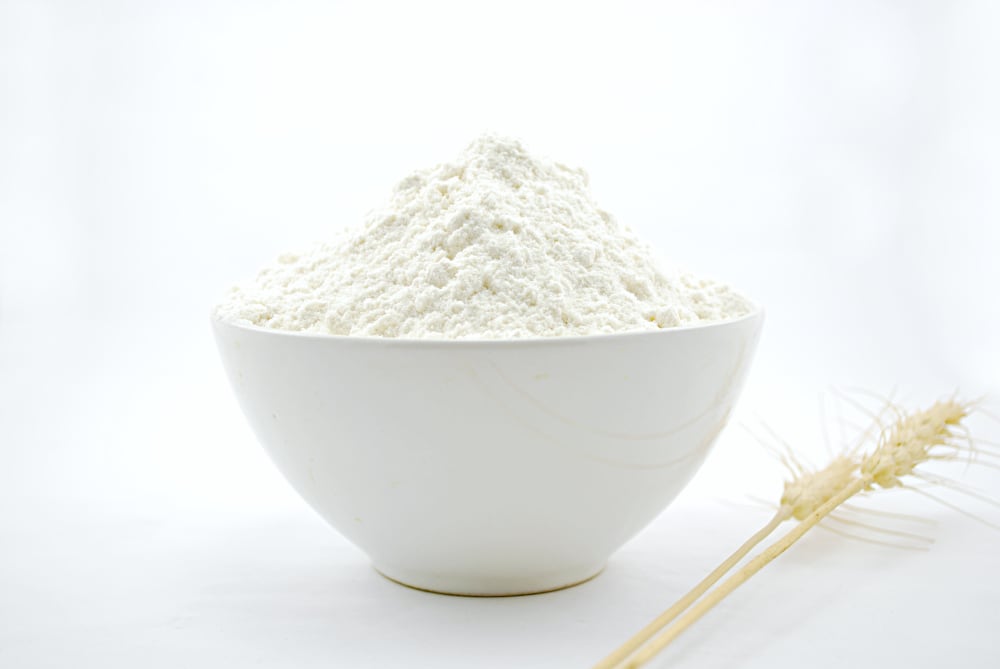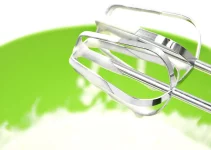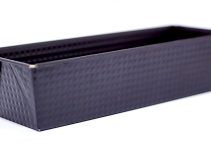The debate bread flour vs all purpose flour is not actually a very complex debate for us to have. These two flours have a lot of similarities and one major difference.
Before going into all those details, I just want to mention one thing. If we’re talking about bread flour vs all purpose for pizza, then all purpose is the clear winner. Flours like the Caputo 00 Pizzeria are some of the best for pizza dough.
Actually, there are plenty of bread recipes that are made with all purpose. Thus, we can draw one immediate conclusion: a strong all purpose flour can be totally used to replace bread flour in a large majority of recipes.
If you’re interesting in more comparison, check out my all purpose flour vs self-raising flour article.
Contents
Bread Flour vs All Purpose Flour: the Major Difference
That one major difference is this: bread flour has a higher protein content than all purpose flour. It produces a higher gluten content, which can make breads have a deeper flavor.
That’s the thing that sets them apart in this bread flour vs all purpose flour debate.
On the other hand,
All purpose flour is the most widely used type. We can use it for breads, pizza, some of the flatbreads, and even for all kinds of desserts. We can make cakes, brownies, cookies, and the list can go on. Various types of pastry can be made with this flour.
It’s basically universal and the best one to have in the house because it will work for whatever you’re in the mood for baking, whether it’s sweet or savory.
Beyond that, there are a lot of interesting things to discover.
Later on, we’ll be talking about how these two flours are made and how to substitute all purpose flour for bread flour and which are my recommendations for the best flours to use for making breads, baguettes, rolls, pizza.
Protein Content

The thing is that the protein content for these two flours is not set in stone, it’s not an exact percentage that must be respected by all manufacturers.
For example, King Arthur informs its readers that their all purpose flour has an 11.7% protein content, while their white bread flour has 12.7% protein content.
It can be considered that all purpose flour can have anywhere between 10 to 12% protein content.
Bread flour, which actually has two branches (white and whole wheat), can have on average an 11-13% protein content.
Or it can go even higher than that, especially for whole wheat flours. It really depends, as I said this is not an exact numbers kind of situation.
Now you see why bread flour is also known as hard flour or strong flour.
So,
If you what to know what is hard flour, now you know that it’s bread flour, which you should be using if the recipe calls for hard flour, although recipes clearly indicate which type of flour should be used, whether it’s all purpose or bread flour.
On the other hand, cake and pastry flour has the lowest protein content, well below 10%, somewhere around 7-9%.
In order to find out the exact protein content of the flour you’re using, check out the nutritional information. If it says that it has 11.7 grams of protein per 100 grams flour then that’s your protein content, 11.7%. It’s information easy to come by.
The Role of Gluten in Bread Making
Gluten forms when flour comes in contact with water, it’s what gives bread its texture, it makes bread airy and chewy, and holds it together.
A high protein content translates into a deeper more delicious flavor and what we call an open crumb because more gas bubbles are trapped during the two rising phases.
The higher protein content leads to more gluten being produced.
The yeast feeds on sugars and starches, which makes the bread rise until it’s good for baking. In simple terms, that’s how bread is obtained.
It’s why we’re saying that you really need just 4 ingredients to make good breads: water, flour, salt, and yeast.
Bread Flour vs All Purpose Flour: How Are They Made?
Both all purpose flour and bread flour are milled from wheat. That’s the major thing they have in common. Wheat is a source of plant protein for people.
In both cases it’s best to look for unbleached flour.
Bread flour is milled only from hard wheat, which is high in protein. It’s great for making all kinds of yeast breads and can also be used for pizza dough making.
Soft wheat is lower in protein and has more starch.
All purpose flour is milled from a combination of both hard and soft wheat. It has a variety of uses from breads to cookies to pizza dough. It’s sometimes referred to as simply flour.
Bread flour actually comes in two varieties:
- white flour – is made from hard white wheat, the whole grain is used, which means that the actual correct name would be whole white wheat flour but it’s simply called bread flour, it’s sweeter tasting that the whole wheat flour and less dense
- whole wheat flour – is milled from the whole grain of hard red wheat, it’s darker in color, is a source of dietary fiber, has a more intense aroma than some might not prefer, especially if they’re used to white bread, and the texture of whole wheat breads is denser, which is why it’s often used in combination with white flour
Prices
All purpose flour is cheaper.
Then comes white bread flour.
And the most expensive of the three is whole wheat flour.
How to Substitute All-Purpose for Bread Flour
The best substitute for white bread flour is all purpose flour. If you don’t have white bread flour, you can definitely use all purpose flour.
The same can be said in reverse: if you don’t have all purpose flour, you can use white bread flour.
As we’ve already established in our bread flour vs all purpose flour debate, these flours are different but also incredibly similar, which makes them interchangeable.
The rise of the dough, the consistency and the texture shouldn’t differ much.
If you’re using whole wheat flour in combination with white flour, you can use both all purpose flour and bread flour. Whatever you have in the house works.
If you can follow the recipe by having the exact ingredients written in the recipe that’s great but if you want to know about how to substitute bread flour for all purpose flour or vice versa the answer is simple: you just do by using the same yeast and flour quantity, there’s no need to change anything.
Best All Purpose Flour
Since we’ve established everything there is to know when it comes to our bread flour vs all purpose flour debate, I thought it would be a good idea to recommend you some of the best all purpose flours for breads as well as some of the best bread flours.
Bob’s Red Mill Unbleached Organic White All Purpose Flour
This is definitely one of the best all purpose flours for bread. It can also be used for making pizza dough, pasta, baguettes, rolls, and all kinds of breads.
It’s not only unbleached all purpose flour but organic, as well. It’s also unbromated. And non GMO.
It has a pretty nice protein concentration of about 11.76%. It can even be used for desserts making if you don’t have anything else in the house.
The all purpose flour from Bob’s Red Mill comes in 5 pounds bags and the price is quite what one would expect from such high quality flour.
This is quite the perfect all purpose flour if you appreciate high quality products.
Another fantastic choice is the King Arthur Unbleached All Purpose Flour.
Best Bread Flour
As I’ve already stated above, bread flour falls into two categories: white flour and whole wheat flour. I’m going to recommend what I considered to be the best bread flour for each of these two categories.
King Arthur Flour Unbleached
What can be said about the King Arthur bread flour except that it’s without a doubt one of the best bread flours?
Well, it’s also quite affordable, comes in bags of 5 pounds or 8 pounds, has a high 12.7% protein content, and it’s perfect for making all kind of breads, rolls, and pizza.
On the bag you will find that this flour has just two ingredients: unbleached hard red wheat flour and malted barely flour. That’s exactly what I like when looking for the perfect bread flour.
They also include an absolutely no-knead crusty chewy bread recipe. That’s a good name for a recipe. In the instructions they recommend using a Dutch oven but I would say that a baking stone works just as great and even a loaf pan would be a good option if that’s what you have in the house.
Great River Organic Milling Organic Whole Wheat Bread Flour
The Great River organic whole wheat bread flour is simply amazing but the price is high.
It has a very high protein content, about 16.66% and quite a good amount of dietary fiber, according to their nutrition facts.
It makes delicious breads, pasta, pizza, rolls, and the list can go on. It’s capable of making very nicely risen dough, you can skip on adding vital wheat gluten for your first try and see how it goes.
The manufacturer states that they’re using locally grown wheat, which is always great, and their whole wheat flour is made by grinding the grains between two millstones. It’s finely ground flour of the best quality.
It’s non GMO, organic, and it’s made from hard red spring wheat.
It comes in very big 25 or 50 pounds bags.
If you want to discovered even more options for the best flours, check out my post on the best flour for bread machine, the flours are the same, whether you’re using your hands, or get aid from a stand mixer or a bread machine.
Bread Flour vs All Purpose Flour FAQs
To condense all that we’ve learned in this debate, let’s quickly answer some questions related to these two very popular flours, although all-purpose is on top in terms of versatility.
1. Can I substitute all-purpose flour for bread flour?
Yes, these two are interchangeable and no modification of quantities is needed. Bread can be made with flour with protein in the 11 to 12 percent range and that’s exactly where all-purpose is situated when it comes to its protein content. The important fact is to use flour of high quality and always the unbleached kind.
2. What can I use if I don’t have bread flour?
More than bread flour, I always make sure to have in the house at least a few bags of all purpose flour. It’s the one that works for making all kinds of baking goods, bread and pizza included, desserts, and pastry.
3. Do you have to use bread flour to make bread?
Not necessarily. It’s important to use a flour that has a protein content in the 11-12% range. High quality all-purpose flour has an 11.7% protein content so, it absolutely works for making breads. Don’t forget to always buy unbleached flour, no matter which type you get.
4. Can I mix bread flour and all-purpose flour to make bread?
Of course. If you don’t have enough of either types, just mix them together until you get the necessary quantity. The end result will be delicious.
5. Is unbleached flour good for baking bread?
It’s called unbleached because it hasn’t undergone a treatment that removes carotenoid pigments and literally whitens the flour. That’s what bleaching does. The unbleached types should be used because it’s a natural product with better flavor.
6. Can I use bread flour for cake?
There are 3 main types of flours that are used for cake baking: cake flour, pastry flour, and all purpose. I have enumerated them based on their protein content from lowest to highest. So, cake flour has a 7-9% protein content, while pastry has a 8-9% protein content. They’re both very similar. The grains are milled until it has a fine consistency is obtain, both are very delicate, just as cakes are.
However, all purpose works very well, too. If we were to make the recipes from Snacking Cakes by Yossy Arefi, we’ll discover that we will just use all-purpose flour. But can you use bread flour for cake? Well, you will be able to bake the cake with bread flour, that’s not the problem. Just don’t expect any tender, crumbly, or flaky texture. It will be chewy and dense so maybe just use all purpose if you don’t have either cake or pastry flours.
All in all,
The general take on the bread flour vs all purpose flour debate is that they are not that different and you can easily substitute all purpose flour for bread flour and vice versa.




